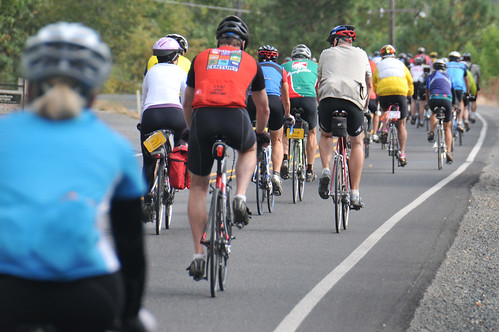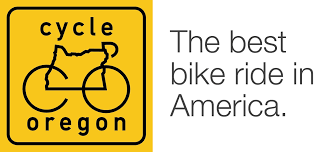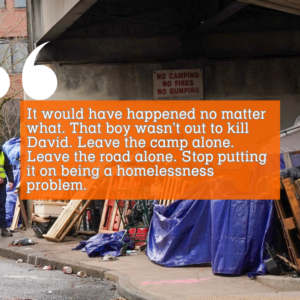This post is sponsored by Cycle Oregon, who’d like to remind you that their Weekend Ride is coming up on July 10-12 and there are still spots available.
Do you remember your first time riding in a group? When you finally got up the nerve to ride a bit closer to someone’s wheel and managed to cheat the wind?
For some riders, the thought of riding in a group is terrifying, others might be curious but aren’t sure how to take the first step and give it a try. Whether you are looking for an aerodynamic assist or simply camaraderie with fellow riders, being able to ride in a group is an essential cycling skill.
With riding season upon us, my friends at Cycle Oregon and I figured now would be a good time to share some tips and hear your input and experiences.
I’ve asked two experts for insight: Tori Bortman is author of The Bicycling Big Book of Cycling for Beginners and founder of Gracie’s Wrench, a Portland-based company that teaches people how to ride bikes and work on them; Jim Anderson is president Team Oregon, cycling team and manager for the Northwest USA Cycling Talent ID Camp and organizer of the Monday Night Race Series at Portland International Raceway.
Tori Bortman
— Be aware of what’s around you and communicate. It’s easy to get lost in the scenery or the conversation with your new friend up that never-ending climb. Make it a point to assume that there is someone coming up or riding behind you who may be faster. Point out potholes, roads narrowing and communicate if you’re pulling over or moving to a new position in the road. If you’re passing someone from behind, let them know you’re approaching. Cycle Oregon is a great place to have a bell installed on your bike. It’s fun and practical!
— Celebrate the diversity of the ride instead of creating divisions. In life everyone has their own agenda and Cycle Oregon is no different. While everyone wants to have a good time, every rider is going to get there their own way– whether that’s leaving at the crack of dawn or getting out of camp late and busting a move down the road. No matter what your speed, there is always someone faster and someone slower than you. Absolutely no one’s way of getting there is the best, there’s just the best way for them. Everyone has a better time when they leave the judgement of themselves and others behind.
Jim Anderson
— Be prepared and predictable. Many new riders in groups tend to get the “stare” and get hipnotized by their riding buddies front wheel and end up staring at that, when they should be looking 2-4 riders ahead in the group. This helps keep the group safe and consistent speed. Since a pace line is similar to an accordion, anything that happens at the front of the group flows backwards and compounds as it goes. Things you can see when looking 2-4 riders ahead are: obstacles, turns, terrain changes and slowing/stopping. Keeping your head up and looking ahead is the way to go – the ride is in front of you not down at the ground!
— When you are on the front, you are in charge. Call out turns, obstacles, traffic and anything else to help keep the group moving safely forward. You are in control. It’s up to you to know the route and make adjustments if needed. Call out obstacles and get your riding mates to “pass” it back though the group. If there is a huge pot hole, take the group around it not through it or split down the middle. Point or call those out with plenty of time.
As you train for your next big ride, soak up these tips and get some practice in with friends before trying to latch onto a new group. As with anything, the more you do it, the easier it will be.
Do you have tips to add? What are your experiences riding in groups on event rides?










Watch for wheel overlap. If someone ahead drifts back so that his rear wheel now overlaps and is close to your front wheel, either drift back to get un-overlapped, go forward, move laterally to put some distance between your wheels, or have a lot of trust.
Don’t hurt those behind you. It is possible to get so focused on what’s ahead that you forget who’s behind, and don’t check over your shoulder before moving off your line. That leads to cutting others off, even taking out a following front wheel.
Learn to hop. In a tight group, you can be better off hopping over a pothole rather than making a big swerve to avoid it. Also learn to momentarily swerve just your bike while your body stays on the same line.
Don’t follow too closely. Your front wheel doesn’t need to be inches from the preceding rear wheel. Separation of a couple feet still gets you a draft and is safer.
Ride smoothly, maintain a constant speed. Don’t speed up and slow down erratically, and don’t hit your brakes unless absolutely necessary. Small adjustments to speed can be made by lifting your torso, drifting slightly to the side to catch wind, or lightly applying your brakes while still pedaling.
Fingers on the brake levers and concentrate, all the time. If your attention is wandering, pull out of line and follow behind.
When you take the lead, maintain the speed. Don’t speed up and drop the group, when you get tired pull out of the lead rather than slowing the group.
Looking ahead several riders in a group is no different than what one should be doing when driving a car in traffic (and yet so many don’t). Thanks for the tips. Some day, I’ll brave Cycle Oregon.
I keep hearing this advice, but I just don’t SEE it as being possible. If you are directly behind someone or slightly off to the side, how can you see beyond them much less several people ahead? I can see terrain changes, but not much else.
Lots of good advice here, but I particularly like Tori’s, about leaving judgement behind. Just pay attention, look (and care) about what is going on around you, including behind you. Be friendly and let everyone else do their thing.
Lastly, if you’re riding Cycle Oregon, it’s first thing in the morning, there are more people on bikes in the five miles of road around you than in the entire rest of the county, visibility ahead is limited only by curvature of the earth, and there is clearly no oncoming traffic…go ahead and cross the centerline to safely and efficiently pass a large group of slower riders.
Todd, you back on the bike?
I am, although I’ve spent considerably more time on my mountain bike and on roads and paths with no car traffic than I have sharing the road. I won’t deny there is a little PTSD there. Is this Chris?
Yep, I’ve been meaning to check in with you. Thought I might see you at the BTA on Thursday. You should stop by the office some time if you get a chance! Also, never cross the double yellow on CO – you could face the wrath of our fearsome enforcement officers!
As you may have guessed, I did face the wrath! Except it was a dashed yellow. My traffic engineer indignation got the best of me. It didn’t help that there was another traffic engineer right alongside. I’ll swing in and say hi!
Ride by yourself and enjoy the view.
When I rode the Oregon coast with my family, the other 5 boys rode in a pace line the entire way, staring at the tire in front of them, and squabbling anytime the leader went too fast or too slow, ha ha. I ditched that plan and rode by myself, and got to see much more of the coastline as a result.
One minor thing to point out.
It’s cool to draft but please ask before sitting on someones wheel, particularly a stranger. It’s rude (at best) and potentially dangerous when inexperienced riders get involved. I find overly aggressive commuters are some of the worst violators.
Not minor at all. It’s bad enough to jump on someone’s wheel without asking, but especially dangerous if they don’t know you’re even there. Communication is key. If you’re working with a small team, agree on how to communicate “up” or “down” with the pace, and it won’t hurt to announce “I’m on” or I’m back on” when bridging up a gap after dropping off for some reason. Great point Mike!
IMHO, the most important thing for riding in a group: High Cadence and a Relaxed upper body. This will tend to keep you from swerving all over the place and causing accidents.
I would say NO to trying to “hop” over road hazards. Chances of staying straight and safe are slim when hopping. But the idea is Right. If you can’t safely move right or left, you hit it and take one for the team. A flat tire or ruined wheel is obviously a way better option than causing an injury.
Chances of staying straight are slim when hopping? Depends how many in your group grew up as BMX kids. 😉
I like drafting and it certainly allows you to go fast or not expend much energy, but some people don’t know how to do it. They don’t call out hazards, vary speed and brake unnecessarily, or move a lot from side to side. If the person in front of you is riding unsafely, drop out of the paceline. If you’re feeling strong, you can ride out ahead and if the paceline catches back up to you, fine. You won’t be behind the hazard any more. If you’re not feeling strong, drop back. It’s better to get to your destination a half hour later unscathed. Unless you are racing (in which case your fellow riders should know what they are doing), speed doesn’t really matter.